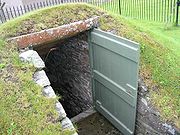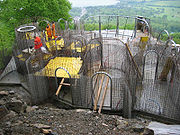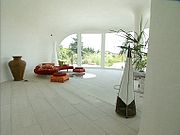
Earth house
Encyclopedia

An earth house is an architectural
Architecture
Architecture is both the process and product of planning, designing and construction. Architectural works, in the material form of buildings, are often perceived as cultural and political symbols and as works of art...
style characterized by the use of natural terrain to help form the walls of a house. An earth house is usually set partially into the ground and covered with thin growth. Modern earth houses are built with concrete walls and insulation.
Introduction
Unlike traditional residential houses built on the ground, the aim of building an earth house is not to live under or in the ground, but with it. If ground and house are separated, a house is built “into the air”, resulting in the loss of heat and humidity, and the exterior shell of a building loses lifespan. The earth house concept uses the ground as an insulating blanket that efficiently protects it from rain, low temperatures, wind and natural abrasion.
The structural engineering of an earth house creates for an organic design requiring spatial sense and creativity. Earth house architecture brings to mind habitable sculptures, incorporating artistic claim and sculptural quality.
The entrance to an earth house can be in the roof. Early earth houses had no windows, but modern earth houses can have windows inside the roof which can mean that more natural sunlight enters them than in an average house.
The earth house does not have to be simple in design or low in cost; "The Burrow" in Canterbury
Canterbury
Canterbury is a historic English cathedral city, which lies at the heart of the City of Canterbury, a district of Kent in South East England. It lies on the River Stour....
, UK
United Kingdom
The United Kingdom of Great Britain and Northern IrelandIn the United Kingdom and Dependencies, other languages have been officially recognised as legitimate autochthonous languages under the European Charter for Regional or Minority Languages...
, went on sale for £2 million in May 2007.http://news.hotproperty.co.uk/Earth-sheltered_home_up_for_%C2%A32_million_18135764.html It featured five bedrooms and was designed by Patrick Kennedy-Sanigar, who is now trying to build a "village" using this type of housing.
Structural engineering

Carl Akeley
Carl Ethan Akeley was a taxidermist, sculptor, biologist, conservationist, inventor, and nature photographer, noted for his contributions to American museums, most notably to the Field Museum of Natural History and the American Museum of Natural History...
in 1911. Akeley patented a device able to spray fine-grained concrete
Shotcrete
Shotcrete is concrete conveyed through a hose and pneumatically projected at high velocity onto a surface, as a construction technique....
. While sprayed concrete is mainly applied in underground engineering and tunnel construction, Friedrich Kiesler was the first to use this technique for the construction of buildings. Swiss architect Peter Vetsch
Peter Vetsch
Peter Vetsch is a Swiss architect, known for building earth houses.- Life :Vetsch was born 1943 in Sax, Switzerland. He attended public school in Sax from 1950 to 1956. He then attended an agricultural school in Cernier until 1962, where he graduated...
improved the technique over several years. To date, he has built over 40 earth houses using sprayed concrete, and he can therefore be considered the leading authority in this area of expertise. The sprayed concrete is applied to a finely meshed metal stretch net which is welded onto the supporting armature. The curvatures are bent and formed according to the intended shape of the building. A 20 cm thick polyurethane
Polyurethane
A polyurethane is any polymer composed of a chain of organic units joined by carbamate links. Polyurethane polymers are formed through step-growth polymerization, by reacting a monomer with another monomer in the presence of a catalyst.Polyurethanes are...
solid-foam-insulation is sprayed onto the outside of the arches, protecting the house from low or high temperatures. A fleece filter mat is then laid on top of this and the building is covered with a thick layer of soil some 80 cm to 3 metres thick. The foundation of the buildings designed by Peter Vetsch are built conventionally. The interior walls of an earth house are furnished using loam rendering which provides superior humidity compensation. The loam rendering is finally coated with lime-white cement paint.
Design and architecture

Peter Vetsch
Peter Vetsch is a Swiss architect, known for building earth houses.- Life :Vetsch was born 1943 in Sax, Switzerland. He attended public school in Sax from 1950 to 1956. He then attended an agricultural school in Cernier until 1962, where he graduated...
or Arthur Quarmby are based on the interpretation of an environmentally conscious, ecological and progressive architecture. They stand out due to their closeness to nature and allow an experience beyond the usual four walls and their right angles. The earth house concept uses its surroundings as an advantage – the surroundings are not adapted to the building, the house is shaped in order to preserve the natural environment.
Modern earth-house architecture incorporates the latest interior finishing, such as contemporary kitchens, bathrooms and house-control systems. Furthermore, every house is newly designed in accordance with the wishes of its owners. Every earth house can therefore be considered a highly individual object. The focus of this planning process is the human being, who is given the opportunity to integrate a “third skin” into his own architectural language. Earth houses can be built as single residential houses or housing estates.
Insulation, energy and CO2 savings
One of the main ecological benefits of earth-house architecture lies in its natural insulation. The unique architecture cools the house down in summer and keeps it warm in winter. A further advantage is the higher air humidity of 50 to 70% compared to overheated rooms of conventional houses in winter. Furthermore, as earth houses are impermeable, they can be considered ideal for controlled air conditioning.Windstorm and earthquake protection
The unique architecture of earth houses protects them against severe windstorms. They cannot be torn away or tipped over by strong winds. Structural engineering and, above all, the lack of corners and exposed parts (roof), eliminate vulnerable surfaces which would otherwise suffer from storm damage.Furthermore, earth houses benefit from improved stability due to the organic shapes of arches.
Landscape protection and land use
Compared to conventional buildings, earth houses fit perfectly into their surroundings. Their soil-covered roofs incorporate the environment and protect the natural scenery. Soil-covered roofs return parts of the green landscape and, therefore, contribute to the oxygen-nitrogen balance. Contrary to conventional roofs, earth-house roofs bring back usable surface. They can also be built as terraced structures if the slope is appropriate, thus using far less land area, because the structure can be built right up to the property boundary.Owing to the condensed means of construction, more green space remains available. Furthermore, earth-house structures can easily be built into hilly terrain, compared to conventional houses, which require flat land.
Fire protection
Compared to other building materials, such as wood, earth houses feature efficient fire protection owing both to the use of concrete and the properties of the earth itself.Roof planting
Roof covering is done using excavation material which allows for planting useful plants. As the roof collects and ties up most of the rain water, rivers are relieved of sudden and huge amounts of water.Light
Earth houses are built using wide glass facades and dome-lights, allowing rooms to become bright and suffused with light. Dome-lights provide natural light for bathrooms and secondary rooms.Civil Defense
Due to the mass of the earth between the living area of an earth house and the surface, and earth home offers significant protection from blast damage and fallout associated with a nuclear war.Disadvantages
The specific architecture of earth houses usually leads to non-righted, round-shaped walls, which can cause problems concerning the interior decoration, especially regarding furniture and large paintings. However, these problems can be anticipated during the conceptual design of an earth house.Unless properly ventilated, earth-sheltered homes can have very high humidity levels, causing mold or mildew growth. The below-ground orientation of many earth-sheltered homes can allow accumulation of radon
Radon
Radon is a chemical element with symbol Rn and atomic number 86. It is a radioactive, colorless, odorless, tasteless noble gas, occurring naturally as the decay product of uranium or thorium. Its most stable isotope, 222Rn, has a half-life of 3.8 days...
or other undesirable materials.
Despite large windows (usually facing south), many earth-sheltered homes have dark areas in the areas opposite the windows. All natural light coming from one side of the home can give a "tunnel or cave effect". This may be alleviated by strategic use of skylights, solar tubes
Light tube
Light tubes or light pipes are used for transporting or distributing natural or artificial light. In their application to daylighting, they are also often called sun pipes, sun scopes, solar light pipes, sky lights or daylight pipes.Generally speaking, a light pipe or light tube may refer to:* a...
, or artificial light sources.

